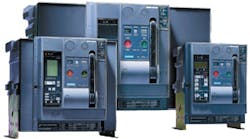In the last five years the NEC, IEEE, and OSHA have agreed on many safety practices and precautions — not the least of which is arc-flash protection. In fact, all three entities have reiterated the need to enforce increased safety measures to protect workers from arc-flash hazards by introducing new industry guidelines and standards. Out of such requirements, an increased awareness among electrical industry professionals regarding the importance of reducing exposure to arc flashes has grown.
Siemens has answered this call by introducing the new Dynamic Arc Flash Sentry (DAS) capability for its WL line of circuit breakers, which, when used with an appropriate safety-rated sensing device, automatically detects when a worker moves within a certain distance of energized equipment and automatically lowers the trip time of the breaker to reduce the potential arc-flash energy. Otherwise known as the arc-flash protection boundary, this distance typically ranges from about 3 feet to 6 feet from the main distribution switchboard in most commercial and industrial applications.
The arc-flash boundary is the distance you must be from a piece of electrical equipment to minimize your exposure to arc-flash burns. It's calculated based on the energy that's available from that equipment, explains Ray Clark, a senior application engineer who's been with Siemens for 23 years and was instrumental in the design and development of DAS. “Obviously, the more energy there is, the farther away you have to be from the equipment to be relatively safe,” he says. “Anyone that gets within the flash boundary needs to be wearing some pretty specific personal protective equipment.”
Available on the company's Electronic Trip Units 755 and 776, DAS can be implemented on all frames in the WL circuit breaker line. Demonstrated for the first time at Power-Gen International 2004 in December, the patent-pending product is actually a new feature of the trip unit, which employs a dual parameter set.
What effect does lowering the trip time of the breaker have on the overall protection scheme for the electrical system? Because trip coordination is not the primary concern, the instantaneous trip may be enabled in most systems (even when set at fairly low levels) and still allow normal operation of system loads. You can make calculations of the arc-flash energy on the available fault current and the operating time of the breaker as determined from the instantaneous settings selected.
How is selective trip coordination affected? The long time and short time settings have little effect on arc flash — the most common overcurrent trip is an overload, which typically occurs in this range of settings. Therefore, you can still achieve good coordination in these sections of the trip curves without increasing arc-flash energy levels. The main area of trip coordination to be affected is the instantaneous range where only high levels of short-circuit currents are a factor. It's in this area that trip coordination must be compromised in order to achieve appreciable arc-flash energy reduction. “The dual parameter provides the vehicle by which the DAS functions,” says John Morrow, product manager for Siemens' WL circuit breaker line. “The DAS is an application of that feature and when combined with some other remote sensing/switching devices, such as a laser scanner, light curtain, or door switch, is an effective tool for reducing arc-flash energy levels.”
In addition to the obvious safety benefits of DAS, the feature allows workers to gain greater manual dexterity and a higher level of comfort when working in high-voltage areas. “Instead of having to wear the bulky clothing that looks like a space suit, including the full face mask with the shield and hood, which would be necessary for very high levels of arc-flash energy, workers can wear a cotton long sleeve shirt with maybe a face shield and some light gloves,” Morrow says. “The potential efficiency improvement this creates translates into increased productivity, which of course trickles down at the end of the day to a better bottom line.”
For more information, visit www.sea.siemens.com.
Product Specs
- Capable of lowering arc-flash energy by implementing faster circuit breaker trip times
- Helps comply with NEC 110.16 when integrated with the appropriate safety devices (laser scanner, light curtain, etc.)
- Allows full coordination up to the withstand rating
- Available on electronic trip units 755 and 776, which can be implemented on all WL circuit breakers




